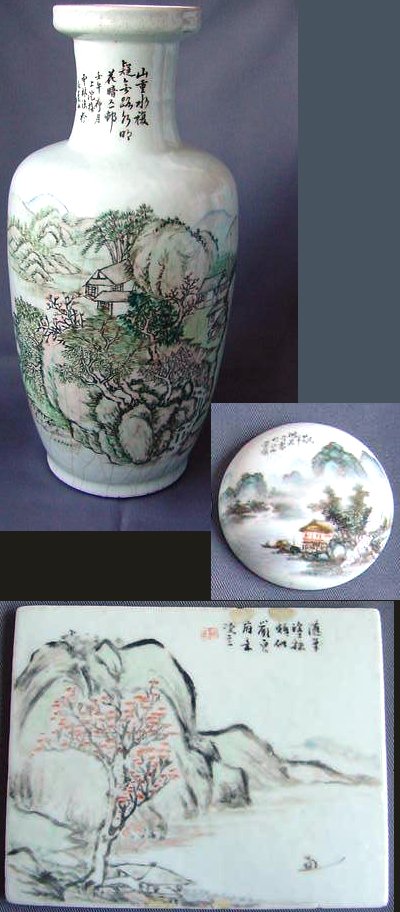
Qianjiang decoration on porcelain. The vase which is dated in the inscription to 1882 is painted in the style of Ni Yun Lin who was one of the four Yuan Qianjiang Masters. The box is dated 1940. Of these examples the plaque is the most typical.
Photo: Simon Ng, 2003
In the latter half of the 19th century, Jingdezhen porcelain artists faced a turning point. With imperial patronage in decline and export markets shifting, many artists turned inward, seeking new outlets for expression and new markets for their wares. This period gave rise to a unique and reflective style of overglaze painting known today as Qianjiang cai (浅绛彩). Rooted in the aesthetics of Yuan dynasty literati painting, Qianjiang porcelain brought calligraphy, poetry, and traditional ink wash painting together on ceramic surfaces with a degree of subtlety rarely seen in previous Qing decorative wares.
Qianjiang means literally "light umber" or "light crimson," originally referring to a Yuan Dynasty literati painting style on paper or silk where landscapes were outlined in ink and filled with pale sepia washes to indicate areas lit by the sun[1]. The term was later applied to a style of porcelain decoration that emulated this painterly quality, using overglaze enamels applied directly to white-glazed porcelain surfaces, resulting in the appearance of watercolor painting on silk or paper.
This new decorative form arose during the late Qing Dynasty, likely in the 1870s, when Jingdezhen artists, facing the decline of imperial patronage, began exploring new aesthetic avenues and commercial outlets[2]. The decorations are pale in coloration and delicate in feeling, in sharp contrast to the richly and sometimes gaudily painted porcelain of the time.
Qianjiang painting on porcelain flourished from the latter half of the 19th century up to the early Republic Period, around 1910. Objects decorated in this style include brush pots, tea wares, bowls, hat stands, and especially flat porcelain plaques designed to be mounted in furniture or display screens[3].
When the style was first introduced on porcelain, it was used primarily for landscapes featuring mountains (shan) and waters (shui) in a distinctive color scheme: ink for mass and shadowed areas, and a reddish-brown for foliage, light, and water. As its popularity grew, more artists began copying traditional paintings onto porcelain surfaces, broadening the thematic scope. Despite this, the name qianjiang has remained as a general term encompassing all styles inspired by literati aesthetics.
The pioneers and most well-known qianjiang painters during the Tongzhi (1862–1874) and Guangxu (1875–1908) reigns included Wang Shaowei, Jin Pinqing, and Chen Men[4].
On this literati style of porcelain decoration, the enamels were often mixed by the artists themselves to achieve specific effects. This pursuit of aesthetic refinement may have led to some technical instability, contributing to the fact that many early pieces today have lost much of their original enamel surface[5].
Qianjiang is a term now used to describe a class of overglaze enameled wares that were particularly popular in the late Qing and early Republic periods. However, the term Qianjiang cai (Qianjiang enamels) or "Qianjiang porcelain" was not coined until the 1950s[6]. Before that, no formal classification of this style appears in Qing dynasty annals or early Republican commentaries. The name was adapted from a Yuan dynasty ink painting style, especially associated with the master Huang Gongwang, known for using varied ink tones and reddish-brown hues to evoke natural light, shadow, and atmosphere[7]. As applied to porcelain, the term eventually described a style that also included pale green, aquamarine, soft blue, pink, and red hues, in addition to its original palette.
The relationship between qianjiang and fencai painting has often been a point of confusion. Technically, Qianjiang uses the same fencai (famille rose) enamel pigments. However, the key distinction lies in the source of artistic inspiration. Qianjiang is drawn from literati painting, especially ink and wash painting, whereas typical fencai works are more closely aligned with gongbi (meticulous) painting and narrative illustration[8].
In traditional fencai, the motif is outlined and then filled with colors layered over an opaque white pigment. Tonal variation is achieved by mixing this white pigment with the colored enamels. In contrast, qianjiang enamel is applied directly to the glazed surface without a white underlayer. This results in a lighter application with fewer tonal gradations, especially visible in early Qianjiang works[9].
One distinguishing trait of Qianjiang work—especially when compared to fencai—is the tendency to avoid outlines. This may reflect a conscious return to hand-brushed painting aesthetics, rather than images derived from gongbi or woodblock prints. It is worth considering that the consistent use of outlines in famille verte and famille rose decorations may have originated, at least in part, from the use of woodblock-printed illustrations as source material for porcelain decorations[10].
The subject matter of Qianjiang painting evolved from early landscape themes to a broader range of literati-inspired motifs, including:
As the style gained popularity, more artists adopted its aesthetic, often going beyond the strict "light umber" palette. Despite this, the term "Qianjiang" has remained as a catch-all for this literati-oriented style of porcelain painting.
By the early Republic period (c. 1910), Qianjiang porcelain had reached its artistic peak. A group of painters based in Jingdezhen—later known as the “Eight Friends of Zhushan” (珠山八友)—played a key role in defining and disseminating the style. These artists, combining painting, calligraphy, and poetry, epitomized the literati ideal in ceramic form[11] were:
Qianjiang porcelain painting represents a moment of refined introspection in Chinese ceramic history—a literati rebirth amid a fading imperial system. Its technical innovations, painterly style, and poetic content place it at the intersection of porcelain craft and ink painting tradition. The eventual formal naming of the style in the 1950s only confirmed what collectors and connoisseurs had long appreciated: that Qianjiang represented not just a technique, but a cultural ethos.
See also: Jin Pinqing (artist)
A